July #6: Harvest Moon

I like July. The second half of the season has just started, the weather is nice, spring crops are almost ready, and you can see fruits grow in front of your eyes at a leisurely pace. But this year—oh boy, this year, July is crazy. It’s like two or three months squeezed into one. There hasn’t been a week without a severe weather warning. It usually starts with an excessive heat warning followed by heavy or extreme thunderstorm warnings. It’s very nerve-racking because my harvest can be devastated within seconds of each thunderstorm on the horizon, I am very happy about buying those hail nets I mentioned in a previous post.
But hail is not the only danger to my plants. Heavy storms usually come with strong wind gusts, and I am quite pleased to say that my vine tomatoes are handling the wind like total sigma plants. However, the toll has to be paid, and this year it’s been paid by one of my apple trees. I lost approximately 20kg of apples, assuming all would survive.


the plague
In the last post, I mentioned my battle with potato rot on my cucumbers. In the meantime, I’ve applied another layer of fungicide as a precaution, but more diluted this time, and I can say that even though it did not get rid of every spore of the rot, the plants are doing just fine. Some old leaves eventually get infected again, but nothing major. However, this should have been a warning and a foreshadowing of what was to come next. The disease I fear most—my precious and beautiful tomatoes got the potato rot.

My garden is located in a community of other gardens, and when I heard a neighbor of a neighbor of a neighbor got tomato rot, I knew it meant trouble. This spreads like the flu, and once you get it, it’s a tedious and often unsuccessful battle.
I know what I had to do. I stripped all my tomatoes of the majority of the leaves. Even though I have some resistant varieties, Sunviva and Primabella, I did not hesitate to defoliate them too. I mixed a slightly lower dose of the fungicide and sprayed everything. Nothing was spared; everything got its dose of Magnicur Finito. After the initial application, I waited two days and went full scorched earth. I mixed a heavy dose, knowing it would burn the leaves, and sprayed only the affected ones. It did burn the leaves—a lot—but it also killed the fungus. I lost only one plant of the Stupické early field tomato and around 30 green fruits.


Defoliated tomatoes and a handful of lost ones.
And as a healthy dose of irony, I guess two plants also got blossom end rot. They just decided that the calcium levels were off a little bit and crippled a few fruits. Fortunately, this is something I can easily solve by dosing the plant with a lot of calcium nitrate and some calcium spray, losing an additional five tomatoes.

the aftermath
Despite the vicious battle, all tomato plants are doing exceptionally well. Due to the accelerated season, tomatoes are ripening almost a month earlier, even though I sowed them pretty late. I had to build additional trellises for my soil-grown tomatoes, mostly for Sunviva, because of the rate and height these plants are reaching. I topped a few of them to stop growing and focus most of the energy on existing fruits. The new growth would probably never reach full maturity with fruits in time, so I decided to stop them.

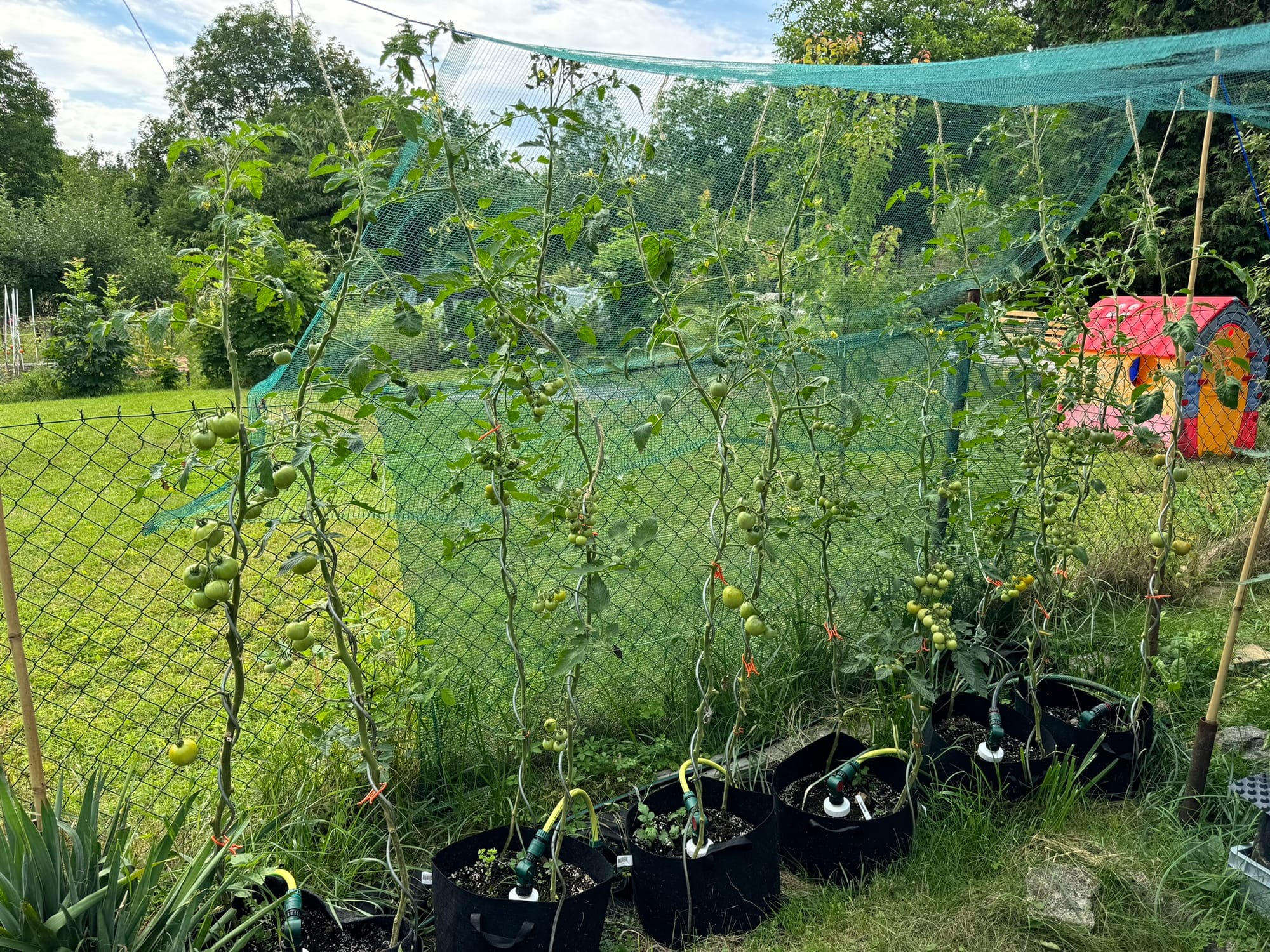
This is my first year growing the Sunviva tomato, and it quickly became my favorite. This yellow tomato is very sweet, and the color is just beautiful. It’s a nice surprise considering that, in the beginning, I doubted it would survive. 11/10 tomato—highly recommend.

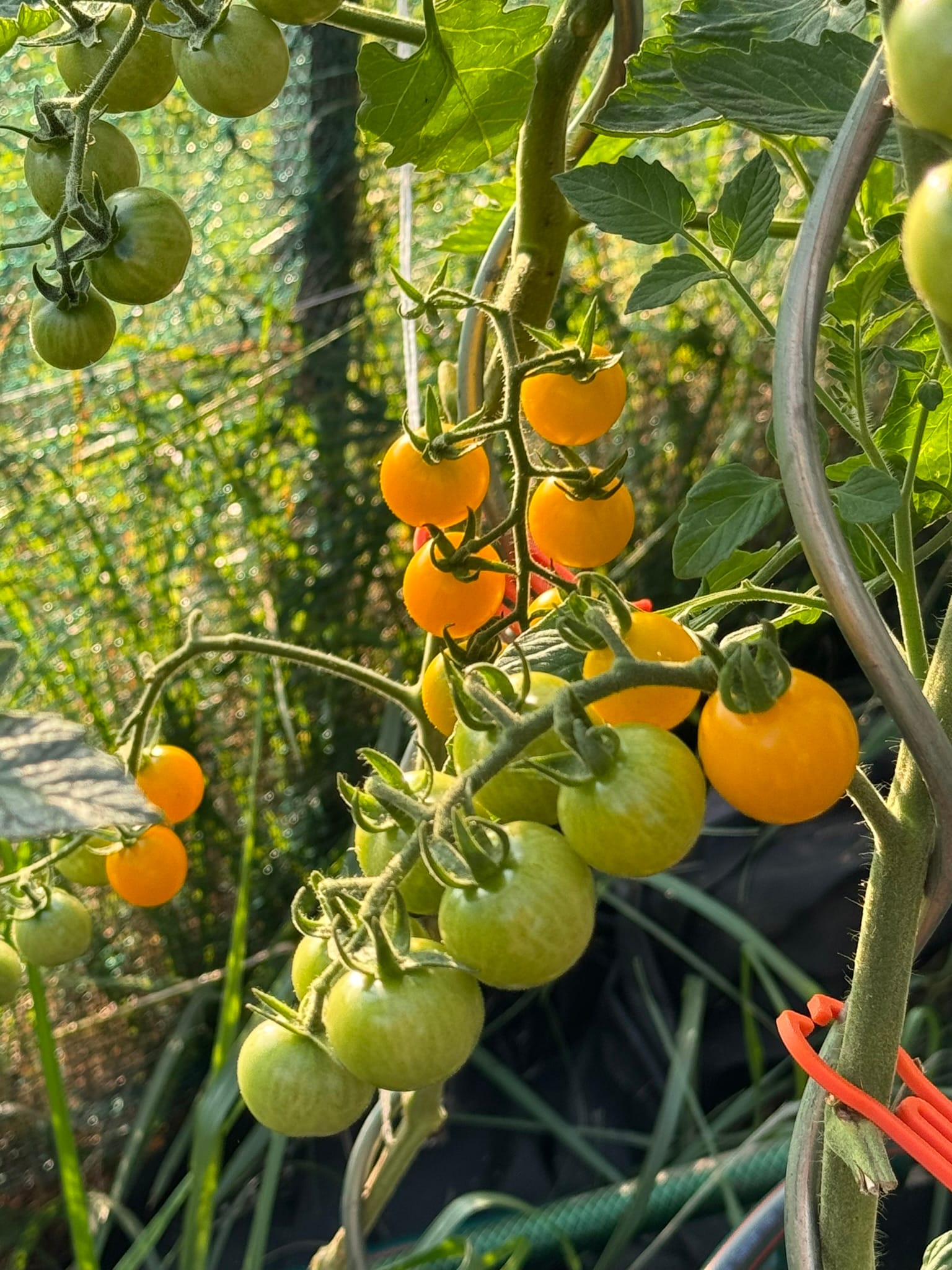
The Primabella, on the other hand, is quite picky. For a long time, it would not grow and seem stunted. It produces nice medium-sized fruit with a nice tomato flavor, but every other day it gives me dying vibes.

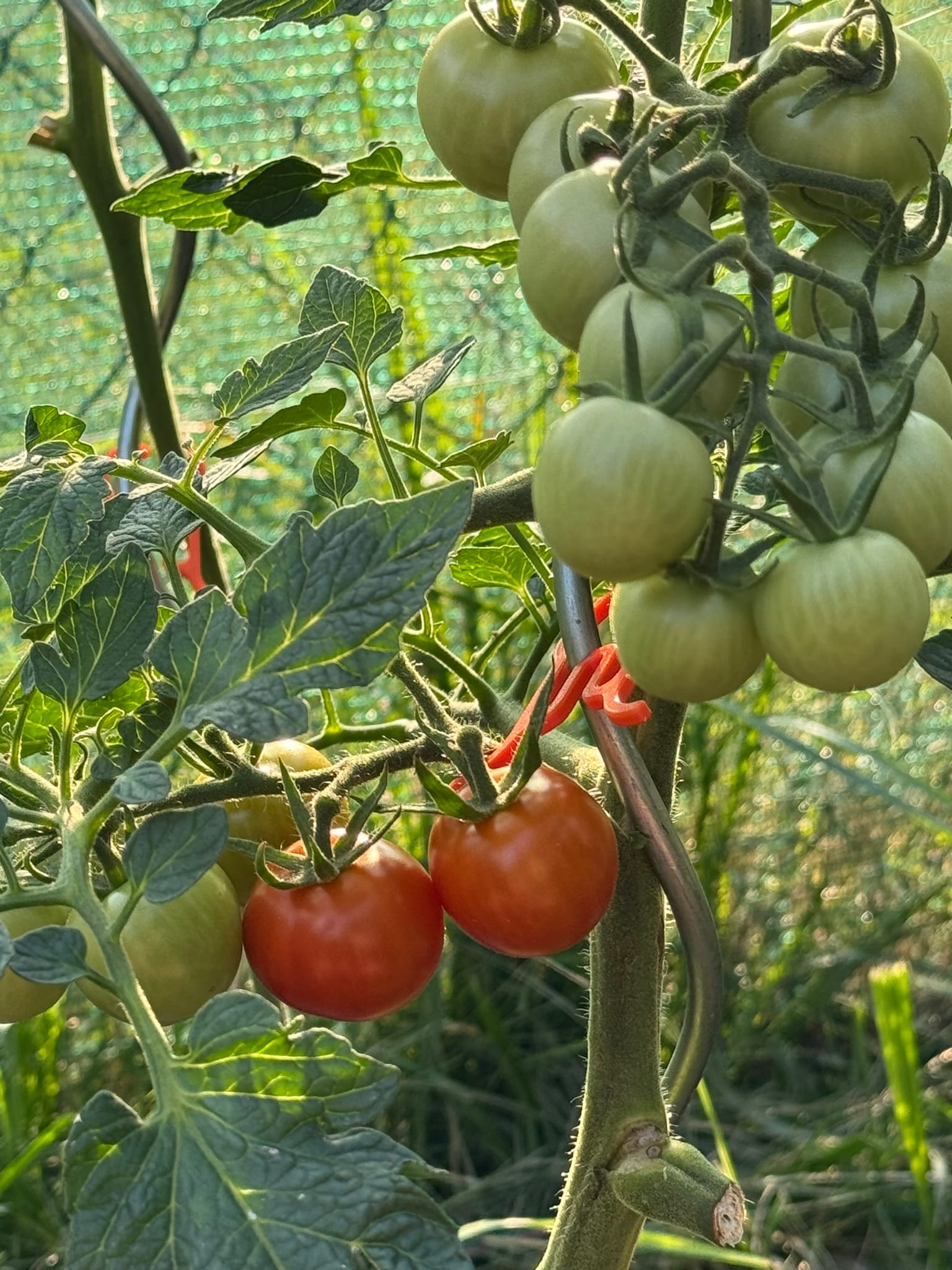
Now for the Stupické early field tomato. This tomato is the most vigorous of them all, growing incredibly fast in this weather. However, they took a hit from the fungus, and I lost a lot of them. I tasted only a few from this year, and as expected, it’s not the best and the juiciest tomato, but it’s very meaty, which is great for sauces and soups. The tomatoes I received as a gift without any other information are very similar to the Stupické. I will have to wait for more fruits to try and identify them, but taking care of them is quite annoying when you don’t know details about nutrients and resistance to pests and fungus.



The hydroponic tomatoes are doing really well and fast. I had to lower a few of them by a few centimeters because the trellis is not very tall. I have to regularly defoliate them because the rate at which the foliage is growing is too high, and new foliage is shadowing neighboring plants and older leaves. At this scale, one can see the main benefit of hydroponics, and that is the water consumption compared to regular soil-grown tomatoes. I filled the 250L reservoir with nutrient solution sometime in May, and only recently did I have to top it, making it roughly 125L of nutrient solution for all 12 plants. VERY ROUGHLY. It might be more; it might be less, but comparing it to over-the-top watering, in which every plant consumes around 5-6L three times a week, this is super efficient.
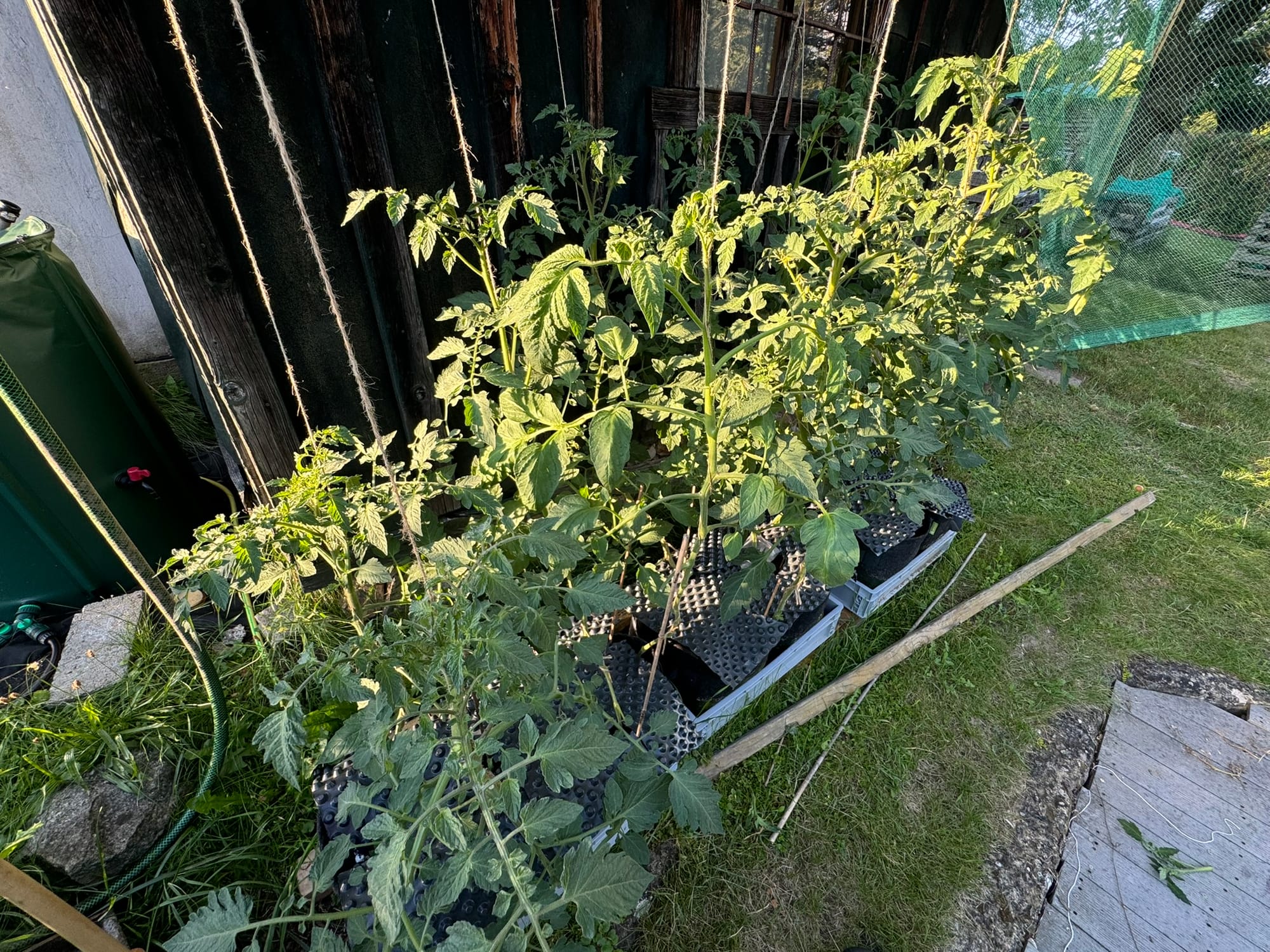



Speaking of efficiency, I have updated my design of the “totally not stolen design of AquaBox” to something more original and not totally stolen. Very original, I know. In the long run, I am not very satisfied with the performance of the design. It performs okay as a complimentary irrigation system and keeps the soil moist. The wicking is too slow to cover hot days and larger plants in summer. I sketched some stuff on paper and figured out that both AquaBox and my design have one fatal flaw. The wick actually has two purposes: water transportation and distribution. And even though it is really good at distributing the water, it sucks in the transportation area. The material makes great contact with the soil, making the distribution of the water from the wick to the soil easy, but it also needs to retain some of that water for the more distant area of the wick. It works okay for the first approximately 50 cm, and then it doesn’t have enough water to give. I will have to run some tests to figure out the exact number, but the 50 cm is observed from a dig-up I did.
The solution? Well, isn’t it obvious? A pipe! I replaced the 1m wick with a DN75 pipe. It serves two purposes. It transports the water from the float valve all across the area I want to irrigate, and it also holds that water as a large reservoir. This pipe is buried almost entirely in the middle of the bed, and smaller wicks are led through slits in the top of the pipe. These wicks then distribute the water in the bed. The top of the pipe is covered either with soil or some mulch. I used grass clippings, but the slits are so narrow soil won’t fall through. It is also great for slow dosing of fertilizer; just dump the liquid fertilizer in the pipe and let it wick.


These wicks make the surrounding soil moist but not overwatered. You can direct each wick to a plant.
And there is no better place than my pumpkins and melons to test this new design. These plants invaded everything in a 2m radius of their home. I first tried to train them in certain directions but to no luck; these plants are thinking independently. They started producing a crazy amount of fruits, and I am planning my cuisine for the upcoming winter. It will probably contain a lot of squash meals with some squash side dishes and a lot of squash desserts finished with a pumpkin spice drink. I wish I could say the same about my melons, but those are probably cursed for me—they only produce male flowers, and all my melon hopes are focused on the greenhouse.


Butternut squash and Sweet Meat Oregon Homestead pumpkin
the wonderful life
And now, mid-post finale! The potato, onion, and garlic harvest. I have waited for about a week to harvest all of my early tomatoes. And for the first year of growing potatoes, I am really happy with the yield. I made several mistakes I won’t repeat next year, and I will probably make different ones, but it is worth it. In my life, I have never had such great and tasty potatoes, but my perception here might be skewed now. The final yield is something around 8kg, a little bit under a kilogram per bag. Not great, not terrible.

The same story goes for the late potatoes. I harvested two weeks after the early ones, and the yield is very similar, which is interesting because for the early ones, I planted three spuds per bag, and for the late ones, only two, yet they yielded the same. And they have a beautiful red color. I’ve actually never eaten a red potato before. They taste the same.
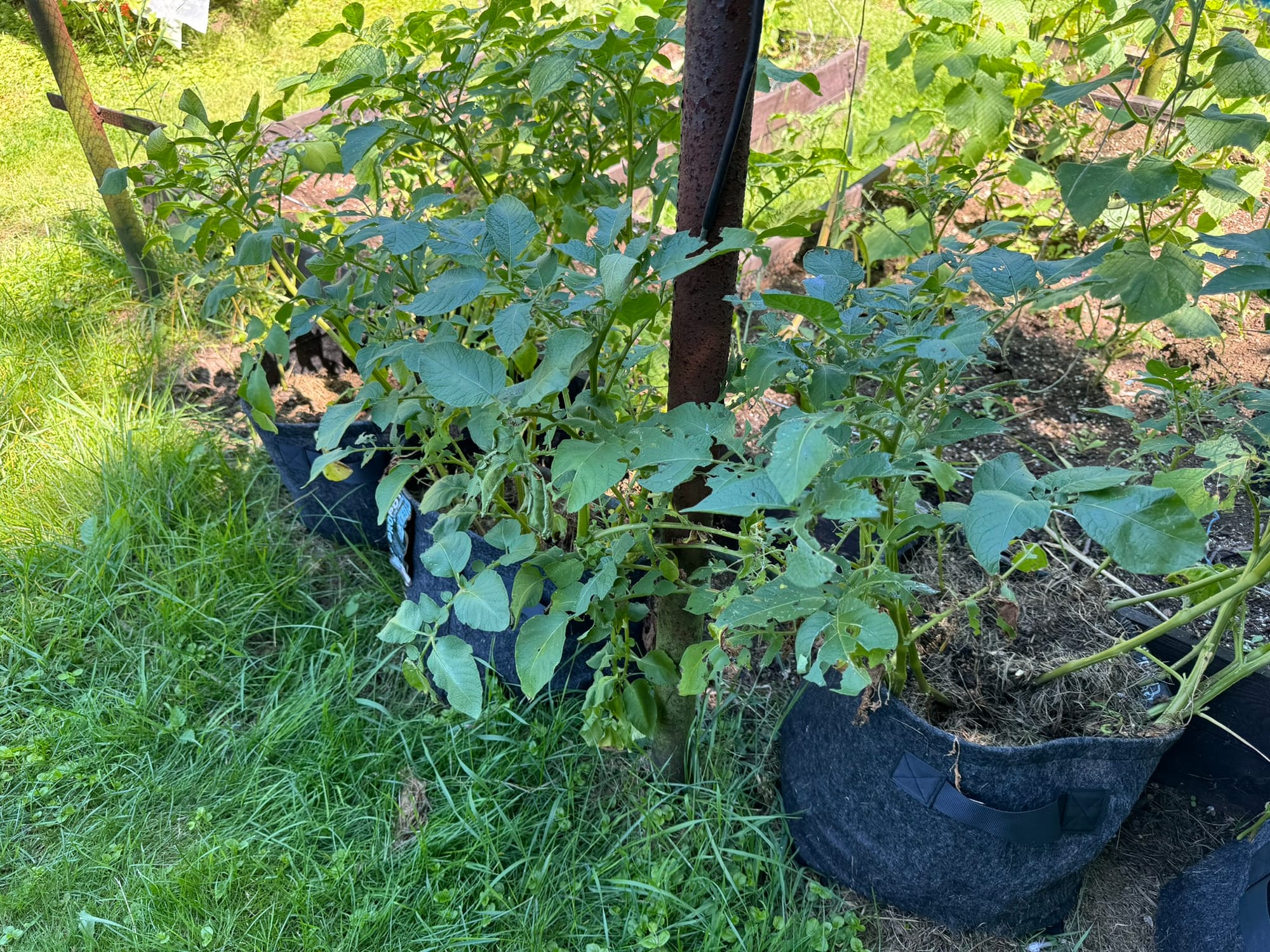


Did you know that potato plants are producing green bulbs sometimes? Me neither.
I have also harvested the onions and garlic, relieving the pickling cucumbers of their neighbor. With the onion harvest, I am happy. Very nice bulbs, juicy but not too much, and great tangy taste. I am also happy with the garlic considering that it’s the first garlic harvest in this spot, but I’ve expected a little bit more. I planted 18 cloves last year, 15 of which survived, but out of the 15, only five are the size I am happy with. The taste though… and aroma. I will be growing this variety next year in a different spot.



I let the onions hang and air-dry for a few weeks to preserve them.
The empty spot after the garlic was filled with some beetroot and salads, though the salads did not survive two nights of slug raids. Gone. All of them. I am now taking care of some kohlrabi that will be planted there in memory of the dead salads.


The pickling cucumbers produce a hefty amount of fruit. The plants are struggling with some fungus, but this is inevitable, and I do not treat these cucumbers with fungicide because it would be pointless. As long as the infection is contained mostly on older leaves and new ones are healthy long enough to help mature small cucumbers, there is nothing to do.




There is a long history of pickling cucumbers. I have some twenty-year-old glasses, and I am pretty sure I would find older ones. My family loves them, but there is one problem. Only my grandma knows the best recipe, and so far I have not learned. I know, shame on me. But on the other hand, I have the best recipe for lacto-fermented pickles in my family! But only because I am the first one to do that.

the greenhouse effect
This solitary plant of melon, which was originally destined for a sad death, spawned two tiny melons! And to not leave anything to chance, I hand-pollinated them to be sure they wouldn’t turn into duds.


The plant is situated in the middle of my bell peppers. And my bell peppers are doing great. All plants have two or more large peppers awaiting their colors. I could harvest them now and have green bell peppers, but I like the sweet ones and hope I won’t have to wait too long.

The Tabasco grows like crazy, constantly flowering and creating new fruits. The peppers are pointy, small, and plentiful. Very similar to the Zimbabwe Birdeyes I did two seasons ago. They pack a pretty good punch for such a small fruit, and I can’t wait to ferment them for my own Tabasco sauce.

Now for the superhots. There is no word that would describe how well some of my Habanero plants are doing. One plant has around 30-40 peppers. This is really unprecedented, and I have never seen anything like that. The plants are not even that big, and the amount of fruit is just insane. I have to admit I am feeding them regularly with heavy amounts of guano and seaweed, but I never expected this. If only there were a way to know what I did right this year. Is it the weather? The early sow? The fertilizers I used? A lot of variables, but I will try to do the same next year and hope for similar results.
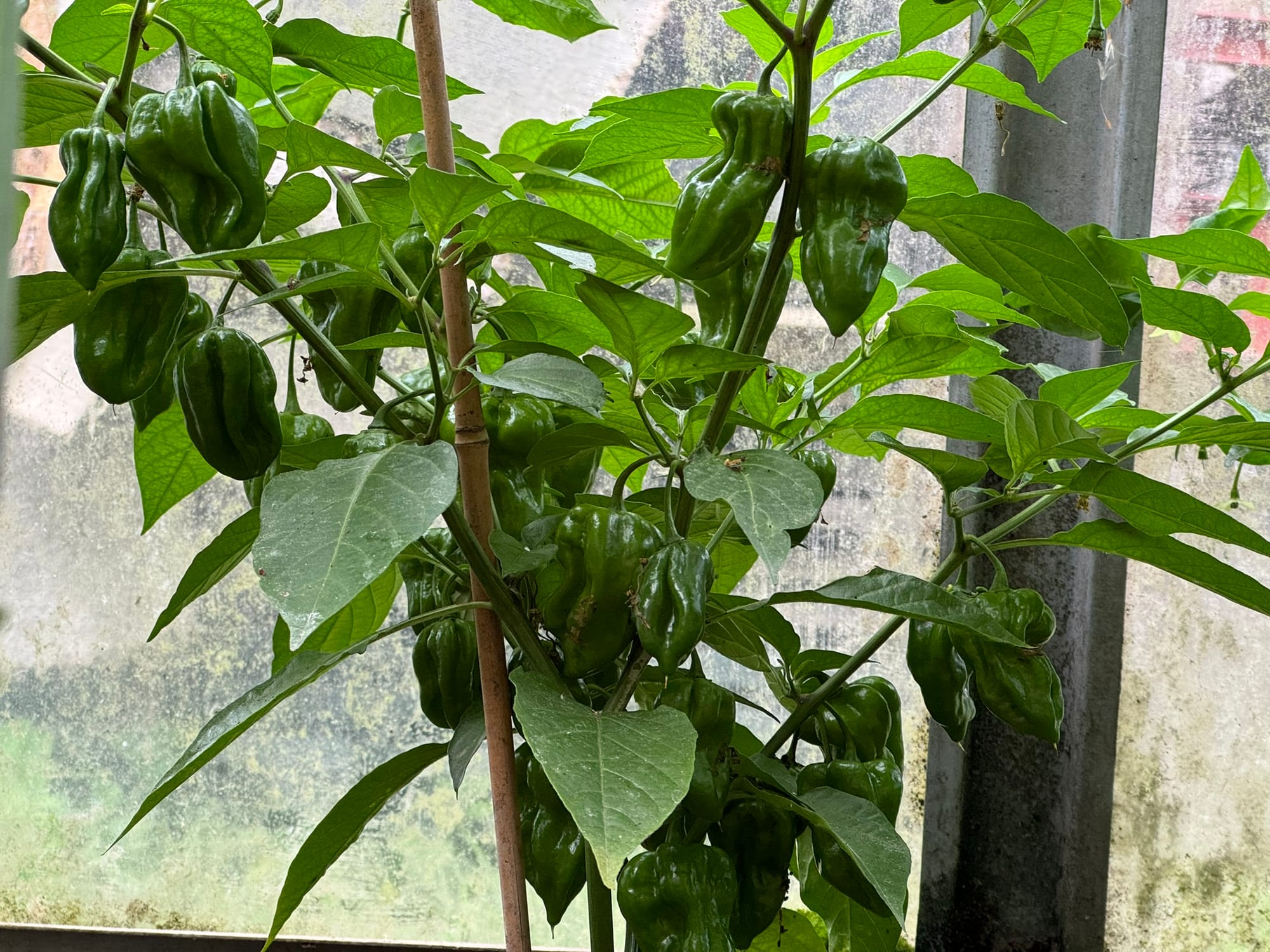



In a very similar manner, I can talk about the Nagabrain Choc, but in comparison with Habanero, the Nagabrain Choc I do not intend to eat raw or use as is for cooking. Don’t get me wrong, I am pretty happy with how the plants are growing. I have already harvested a handful of peppers, but as with any crazy hot variety, you can’t just go around your kitchen and throw it here and there to give the food a little bit of heat. Going around with Nagabrain Choc is like going around with a nuclear warhead for self-defense. Too damn hot! And it’s a shame because the taste would be great—tangy and sour-sweet like eating a lime peel if it weren’t for the incredible heat. You have to process the pepper and use some medium to dissipate the heat while keeping the flavor. The obvious way to dissipate the heat is by mixing it with a heavy amount of vinegar. This will also stabilize and preserve the pepper for a long time. However, it alters the taste a lot, which is why I don’t like using only vinegar. I like to take the long path and lacto-ferment the hell out of it. Lacto-fermentation is a process of preserving food by converting sugars inside into lactic acid. The lactic acid stabilizes the food the same way vinegar does, but it also does not interfere with the taste that much. The most noticeable change in flavor is the loss of sweetness. This may sound a little bit unappetizing, but it only allows the other flavors to be more noticeable. The downside of this process, however, is the amount of liquid one pepper contains. These superhots are not very meaty, and there is not enough liquid in the flesh to dissipate the heat. I usually add other vegetables with similar flavor profiles to ferment them together with herbs and spices. The go-tos are onion and garlic; sometimes I add slices of orange accompanied by a stick of cinnamon, and sometimes I add limes and basil to make a hot sour sauce great with fish. If I touched your nerve of interest right now, you can expect a post about fermenting peppers, making sauces, and brewing some homemade alcohol from pineapple peels in the fall.


Last time, I battled for the life of my cucumbers, and the battle paid off with some nice cucumbers for a salad and gin & tonic. The method of infinite growing is really great. The plants are compact, do not shade other plants in the greenhouse, do not make the air overly moist and since I am stripping them of old leaves, there is no time for fungus to consume them. I mismanaged the fertilization a little bit, and some cucumbers turned hook-shaped, but who is going to notice in the glass with ice?



And the crown jewel of the greenhouse, and a transition to windowsill greenhouse tomatoes, the beautiful Red Robin tomatoes. Bushy, healthy plants filled with a lot of cute little juicy tomatoes. A little bit too bushy for my taste, I told myself and defoliated most of the leaves for better airflow. The defoliation at this stage does not hurt the plant; most of the leaves are shaded anyway, and shaded leaves are just useless. As long as you leave some leaves for photosynthesis, the plant will be just fine. The energy from those dead leaves is redirected into fruits and new foliage. For the determinate tomatoes, there is really no way to stop the foliage growth. With indeterminate tomatoes, you snip the top and then every offshoot as usual, but with determinate ones, if you snip the tip, it just spawns two new shoots. And with such a small plant, it’s hard to spot all of them.


Before and after defoliation



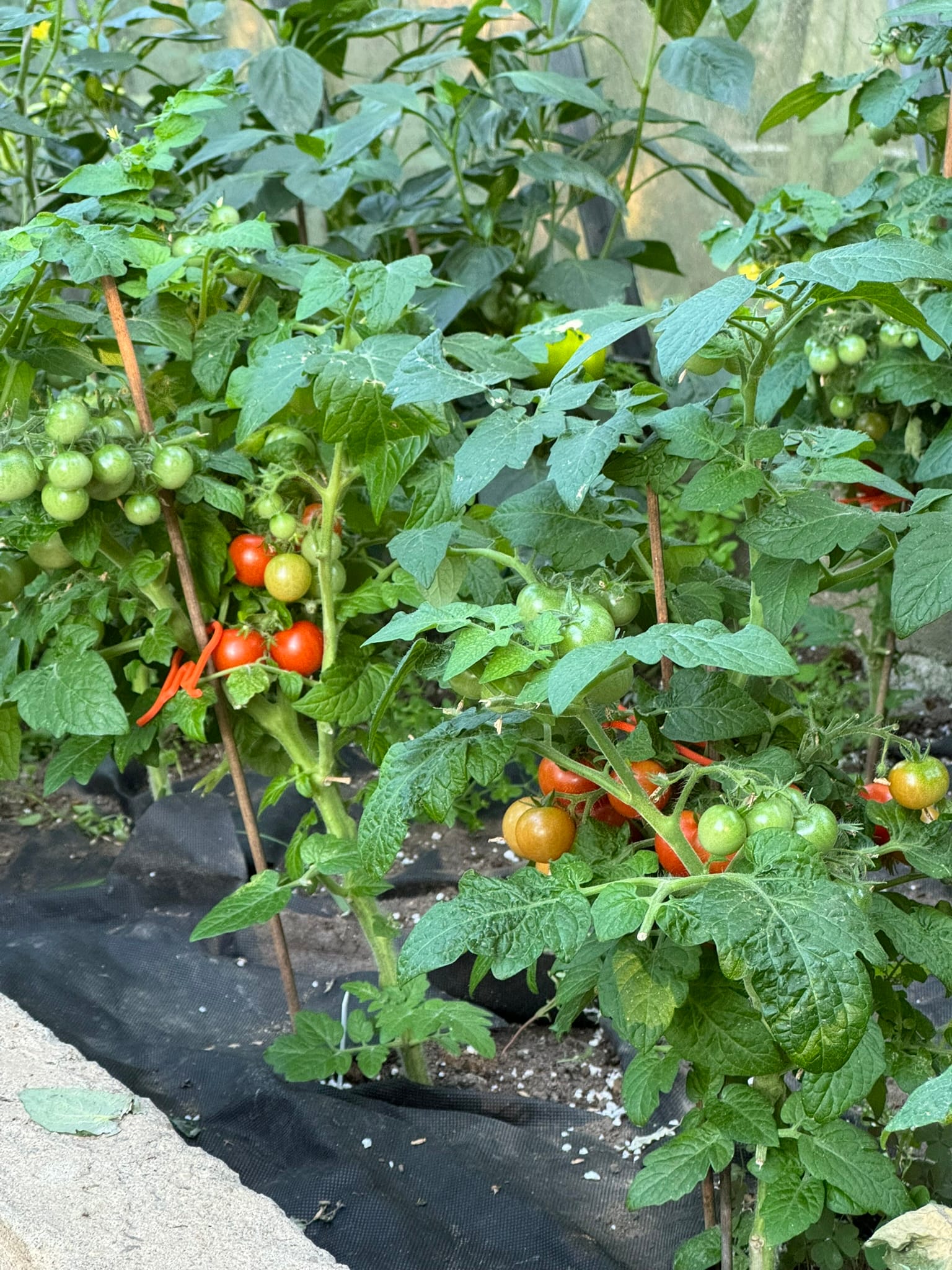


On my window, the coco Micro-Tom got some grooming too. The plants are now producing fruit, and so far, it looks like they will be ripe in September just in time to prolong the season up until October. The stray indeterminate tomato, now finally identified as Sunviva, has finally left the greenhouse and now it’s sticking outside. The fruit it produced is really tiny, and I wonder if it stays the same.
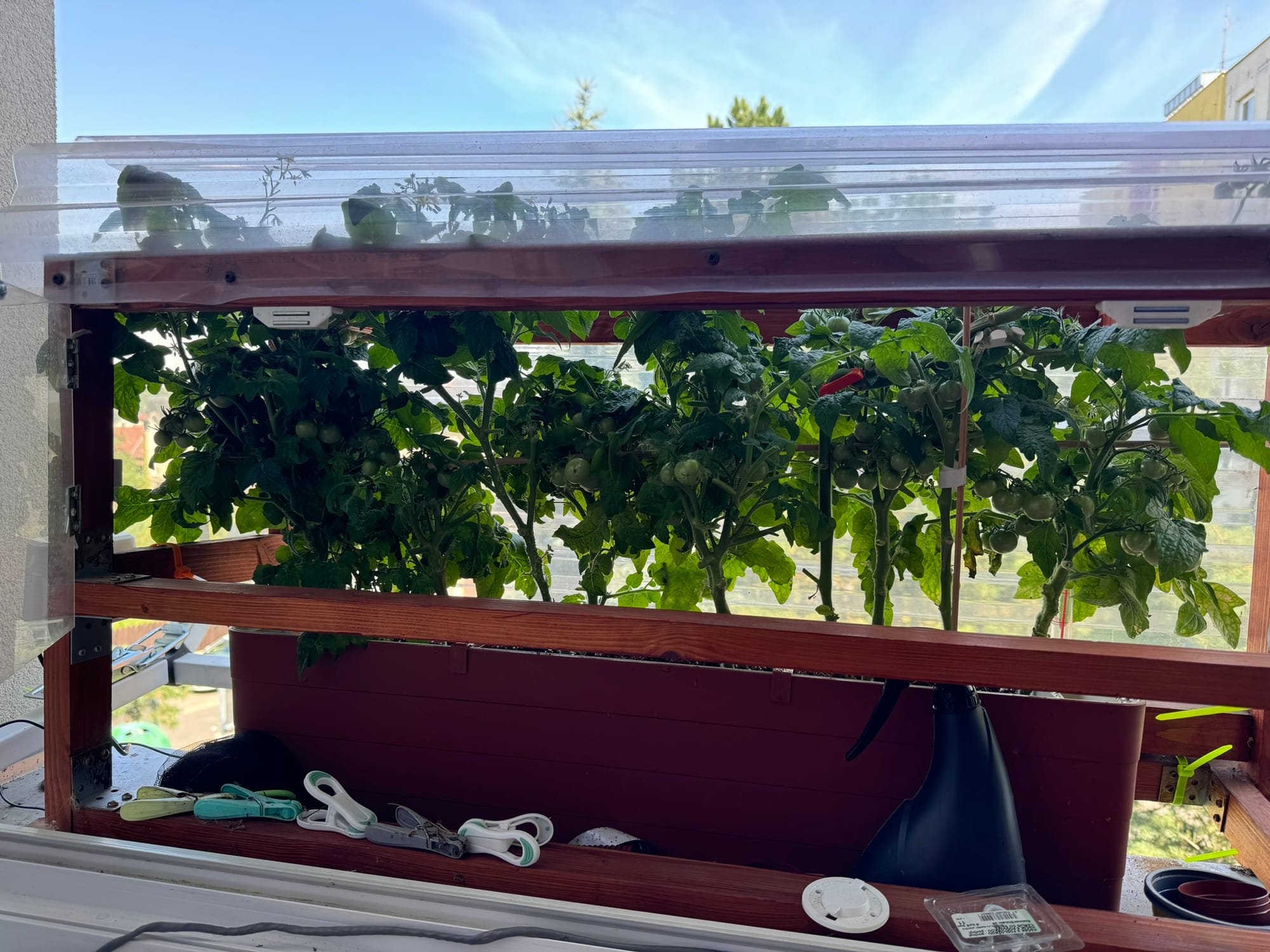

I will be leaving for a vacation sometime in August and have to take the necessary precautions. This post is long and it comes later than usual just because there might be a longer delay for the August update which might be just a disaster report.
Member discussion